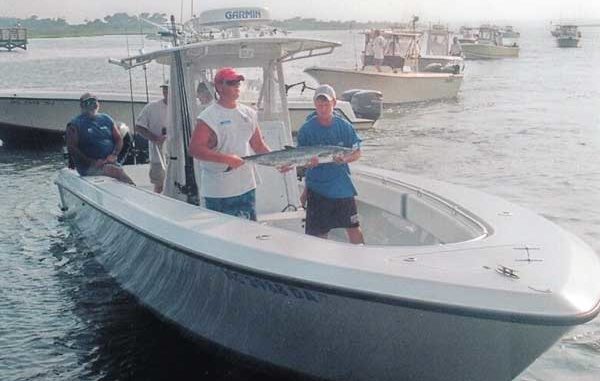
Sitting in the catbird seat of saltwater management, DMF director Louis Daniel explains what changes N.C. may see in the future.
The old Johnnie Mercer’s Fishing Pier at Wrightsville Beach was where Louis Daniel, director of North Carolina’s Division of Marine Fisheries, began his love affair with the ocean.
Long ago his dad introduced the young Daniel to fishing at local ponds near Pinehurst, but a trip to Mercer’s pier with his grandfather really hooked the boy on saltwater species.
“I got introduced to pier fishing by my grandfather,” Daniel, 44, said. “I went out there to catch spots. I was about 7 years old and thought it was the coolest thing ever.
“After that, every time we’d go to the beach, that’s all I had any interest in doing. When I got old enough to stay at the pier by myself, I’d spend two weeks on Johnnie Mercer’s Pier. I didn’t come off that pier from sunrise to sunset until my parents came and got me.”
That early interest remained with Daniel. Even though he planned to follow his father’s footsteps and become a doctor, he changed his career focus while at Wake Forest University.
“When I was at Wake Forest, I missed a class I needed, one of those pre-med courses,” he said. “But I took a class called invertebrate zoology; it was either that or botany. I was like ‘I don’t want to take either one,’ so I guess I’ll take invertebrate zoology; it sounds better than plants.
“I got in (the class), and it was all coastal, all marine, except for the bugs. After that class, I didn’t want to go to med school any more, I wanted to go to graduate school in marine science.”
With a bachelor’s degree in biology from Wake Forest, Daniel went to the College of Charleston where he received a master’s degree in marine biology and later earned a doctorate in marine science from the College of William and Mary.
Armed with his doctorate, Daniel accepted a position with the U.S. Fish and Wildlife Service where he spent much of his time forming fisheries management plans for military installations and suggested eastern-based Fish and Wildlife offices become more involved in coastal fisheries issues.
His work led to his involvement with the weakfish technical committee and bluefish committee with the Atlantic States Marine Fisheries Commission. Daniel continued to serve on various committees, including the stock-assessment subcommittee, the plan-review team and plan-development team committees when he joined the N.C. Division of Marine Fisheries in 1995 as a biological supervisor. For nine years he served as an executive assistant to then-director Preston Pate. In that capacity he moved off the committees and onto some of the boards, working extensively with the South Atlantic Fisheries Management Council and serving as the chairman of the council from 2004-06, Daniel also served on numerous management boards for the Atlantic States Marine Fisheries Commission.
He took time recently to answer some questions for North Carolina Sportsman magazine about the challenges of his new position.
Q. What is the main difference in your other jobs at the Division of Marine Fisheries and now as director?
A. The big difference has been to become familiar with the many programs we have. I don’t think anybody steps into this job and is able to know all of the habitat, permitting, resource enhancement, information technology, license and statistics and biological side of this job. It’s a trial by fire, really.
In the previous positions I held, I had little involvement in personnel issues, with budget issues and with many of the programs that I wasn’t involved in, like resource enhancement, artificial reefs, oyster-shell recycling, the oyster-sanctuary program, the license and statistics program, the coastal recreational fishing license and now this waterfront-access and marine-industry fund that was placed on the division’s plate. You do a lot of direction; it’s an appropriately-named position. You’ve got to move from issue to issue and can’t dwell on any ne issue for too long.
Q. What is your biggest challenge as director today?
A. I think it’s a combination of things, but I think (public) education of our mission is probably our single biggest challenge. If I had to say what is the one thing that creates more problems for us and for me, it’s an education of what it is we’re trying to do. I don’t think the public is completely aware of all that we have to do and that we’re trying to do.
It’s not a popularity contest when it comes to fisheries management issues. It’s a federal or state mandate as well as a mission statement. And our mission at the Division of Marine Fisheries is to protect and enhance the marine resources for the citizens of North Carolina. It’s not for one user group; it’s not for just folks to look at them (marine species) in an aquarium. It’s for every user group. So the person in Asheville who just likes the thought of snowy grouper swimming around in deep water is just as much a N.C. citizen with rights to that resource as a bona fide commercial fisherman who goes after snowy grouper. As is the case for speckled trout, as is the case for red drum — not to allow fisheries management by public opinion when it comes to allocation. Trying to put into perspective the goals and missions of the division.
Now if it was maximize the value of the resource, we might have a different approach to the resource, but it’s not. So I’m directing the charge of the General Assembly, the department, the state, and in some case, the federal management programs to manage for the resource.
Q. What specifically are you doing or have done since you have become director to meet that challenge?
A. One of the things that I made a first priority was to construct an anglers guide. (It’s) a nice glossy book used for educational purposes to try and get out the information about the Division of Marine Fisheries and what our mission is but to also try to indicate what our challenges are and the importance of fishery-management plans, the importance of the coastal habitat protection plan. But then also have fun stuff — here’s the fish, how to catch them, when to catch them, access points. What we tried to do is look at all the state resources agencies that have put out these nice anglers books and take from the best ones.
Also, (DMF is) trying to put out a formal newsletter to the public. We’re still working on that, and I’m hoping to get that done by the first quarter of this year and be posted on our web site.
Q. How many coastal recreational fishing licenses were purchased the first year and how did that compare to the anticipated number you were looking for?
A. The Marine Recreational Fisheries Statistics Survey estimates in 2006 was we had a total of 588,000 coastal recreational fishermen and 1.34 million out-of-state for a total of 2.2 million fishermen.
We sold 314,173 state licenses compared to the estimate of 588,000. The out-of-state licenses we only sold 155,392, the estimate was 1.34 million. (So) our total MRFSS estimate (was) 2.2 million (and) actual sales (were) 469,000 — quite a difference. There are a couple of caveats that need to be made. First, 261,000 lifetime sportsman’s licenses are grandfathered in to the coastal recreational fishing license. If you add those lifetime sportsman’s licenses to the 314,000 we sold, you come up to about our in-state estimate.
Obviously we know that not everybody with a lifetime license fishes in saltwater, but a lot of them do. Also you have to remember (the number of licenses sold) doesn’t include anyone under the age of 16. The MRFSS estimate does.
I’d be hard pressed either way that we are off base too far with our in-state license estimates. Where you’ve got to do is some creative thinking when you try to resolve the discrepancy between the sales of the out-of-state licenses, the 155,000 compared to the MRFSS estimate of 1.4 million.
I would have expected the coastal license numbers to have been even less because we said we would go a year before we did the full-blown one-strike-and-you-get-a-ticket if you don’t have a license. People knew they’d at least get a warning before they got a ticket.
How did that impact license sales? I don’t know. We might get an estimate on that next year this time when we see our license sales the second year.
But what’s crucial in that shortfall of 1.2 million fishermen from the out-of-state component that we have missed are the blanket licenses, 825 charter/headboat boat licenses and the piers are blanket licenses. All the piers have gotten the licenses. Seventy percent of the pier anglers don’t have a license, 86 percent of the charter boat anglers don’t have a license, and 93 percent of the headboat guys don’t have a license. So you’ve got a huge number of people (covered by blanket licenses). You start adding up a lot of people making up that 1.2 million discrepancy.
What’s important is we put in the data-collection programs to find out exactly what those folks are doing. Bottom line, I don’t think you can just look at the number of licenses we sold and compare it to the MRFSS estimate and compare those two; they’re just not comparable numbers.
Q. How is the money handled from the coastal recreational fishing licenses and what type of projects will this money be earmarked for?
A. There are two separate trust funds — the marine resources trust fund is where all the money from all the annual licenses goes. Then there’s the endowment fund from lifetime license sales.
Implementation of the program, $375,000, and the stock-assessment specialist position that was granted in the General Assembly this year, was approved but has to be funded is about $100,000.
I’ve been in contact with leadership of the recreational fishing community and said, basically, if you had $1 million, what would you do with it? The answer I got pleased but surprised me to some degree.
Most everybody agreed we need better data. The other thing folks wanted to see was educational materials. Another was somebody to serve as sort of a sportfishing specialist, a sportfishing liaison, someone with the Division of Marine Fisheries at a sort of senior staff-level position who would go to the (Marine Fishery Commission) meetings, would be a contact for the recreational community, for information purposes. (That person would) help put together ideas, go to Coastal Conservation Association banquets, go to fishing clubs, go talk and get education out. I thought that was a neat idea that came from some of the leadership of the recreational fishing community.
That’s what I tried to focus some of the projects early on (and is) why I pushed for this anglers guide that was funded. Another project we funded early on with the N.C. Wildlife Resources Commission on the Chowan River was to turn the old Highway 17 bridge into a fishing pier — put in a boat ramp, boat slips, a concession stand — but turn that old DOT bridge into a recreational fishing pier.
The other project we are waiting for, hopefully to get approval for a large capital-habitat project. Dumping airplanes in the ocean doesn’t really enhance habitat, but how do you create fishing structure for recreational fishermen, how do you enhance shellfish stocks all at one time?
The thing is to expand our oyster-shell recycling program and expand our oyster sanctuary program. So what’s in the proposal right now is a 30-acre oyster sanctuary somewhere off the Engelhard-Swan Quarter area that would be off limits to any shellfish harvesting techniques but be an area where we could build habitat. It would be a fish haven, would help rehabilitate the oyster population and would also help with water-quality issues. That’s a program everyone seems to have embraced.
Q. Do you think that increasing the number of red drum that can be kept by commercial netters from seven to 10 fish is a good idea?
A. No, because we have moderated landings, and we’re seeing a good stable rebuilding, what folks need to understand is even though we’re no longer overfishing because of the controls we have put on the fishery, (red drum) still are overfished.
When you are dealing with a stock that lives to be 50-plus years old, you’re not going to rebuild in 5 years. It’s going to take a long time.
So the questions is what do you want the red drum resource to look like? We could probably manage this fishery and increase the bag limit by a fish and increase the by-catch allowance by three fish or double it. But you wouldn’t see the healthy age structure we are shooting for.
So I can’t support any increase by either side. It’s our position we need to do everything we can to minimize the discard mortality in the recreational and commercial fishery. The more we encourage the use of circle hooks, particularly in the trophy fishery by the recreational fishermen and to encourage or mandate more restrictive gill-net attendance and area set requirements (those measures) try to minimize the number of discards.
Q. What is the DMF doing to help the river herring stocks and how long do you think that will take?
A. I don’t know that they ever will recover. If you go back and look at the original stock assessment that John Carmichael did for the original plan, he told us unless we had an extraordinary recruitment event, it was possible that that stock wouldn’t recover. We haven’t seen it yet, and that’s why we’re in the scrape we’re in right now and that’s why the last-ditch effort was to put in a moratorium and hope it will indeed come back at some point.
We’ve had a lot of support from the General Assembly to fund the positions we need to do the strategic habitat area definitions for river herring, identifying the spawning areas, identifying places that are suitable for trap and transfer if we need to.
I drafted a letter back in the summer to the Virginia wildlife crowd, requesting their assistance in herring management in North Carolina and I was very impressed and very excited about the response I got. They actually closed the rivers that lead into North Carolina. That is a real positive step forward.
After we implemented our moratorium, I went to the ASMFC in my role as the new administrative commissioner for the state and requested we move forward with a coast-wide moratorium on river herring. We have actually gone out to public hearings on that.
What I’ve recommended, not only that we close state waters coast-wide to river herring, but then we also request the councils identify those fisheries where significant river herring bycatch is occurring and also get the Secretary of State to require this of Canada, because this is a multi-jurisdictional fishery and just the stuff we are doing in North Carolina is not going to cut it if we want to see a full-scale restoration of river herring. There has been a lot if interest and a lot of support in trying to put together a program to keep this on the front burner.
Q. Do you think establishing Marine Protected Areas will help bottom fish rebound and do you have any problems with the policies with creating some of those in North Carolina?
A. You are dealing with the toughies. I guess my position on MPAs, I think I’m being consistent in that I’ve always had some problems with them because I don’t know how you are going to monitor them. I don’t know how you’re going to enforce them. Now I’m talking about the offshore version.
When you’ve got a 10×10-mile block, 60 miles offshore, from a pure marine resources application, I don’t know that you would be able to ascribe any kind of benefits to the resource to that 10×10 block. I don’t know how you’d do it. There may be a way down the road.
The only way I was able to support MPAs, the reason I voted for it, was habitat protection. Clearly those areas are important habitat or else those fish wouldn’t be there. The fact that you’re seeing spawning aggregations of some of these species on these reefs means it’s important.
Now, will you be able to characterize the help you gave it? No, probably not, but you can certainly keep folks from drilling for oil there, and you can do your best to keep at least these vessels with Vessel Monitoring Systems from trawling through those areas and doing things that would disrupt and destroy that habitat. There’s no doubt it’s a positive habitat issue.
Then the enforcement thing, it has always bugged me just knowing even 1 percent, one-half percent of the fishermen that went out there said, ‘Hey, let’s go try that MPA real quick,’ you could have a windfall day and the likelihood of you ever being seen out there in that deepwater stuff is pretty daggone remote. I just don’t see how you can enforce this law effectively.
Q. What about Limited Access Privilege Programs (LAP)?
A. The question becomes would you prefer to have longer closed seasons, smaller trip limits or a dedicated catch level? That’s the question N.C. commercial fishermen seem to be split down the middle, 50-50. We’re in the process now of providing them with scenarios on how LAPs would work and trying to move them in a direction to where at least that if they come down through the federal council process that N.C. fishermen and our commissioners are aware of what the issues are associated with LAPs.
There are a lot of opinions about them out there. There are some people that absolutely can’t stand them and there are some people who think they are the savior to the commercial fishing industry.
I think what’s the savior to the commercial fishing industry is what they can all agree to and adhere to.
The thing I’m trying to get across to the commercial folks in this issue is that. Don’t downplay it because of its unknown factor because you can develop a LAP program that you can tailor to any circumstance you want.
It seems to me with fuel prices they way they are, with the lower and lower Total Allowable Catches, we’re seeing in these federally-managed species, you’re going to see seasons that go from 12 months to three-month seasons. And if you happen to be in the geographic area and the fish aren’t there during that three months, you are going to be out.
I’m going to stick to my guns and say the commercial guys are going to have to make that decision as to how they want to see their fishery managed and if they prefer closed seasons and closed areas to dedicated privileges then at least from the N.C. perspective, that’s the way it will stay.
It has been authorized in the reauthorization of the Magnuson Act to move forward with LAP programs. So you’re seeing the councils moving forward and you are going to see it coming on snapper and grouper in the not-too-distant future. Then the next logical species for commercial side would be king mackerel. It’s real; it’s there and it’s coming.

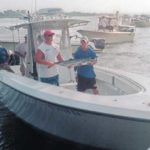
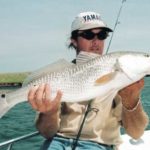
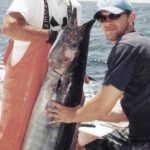
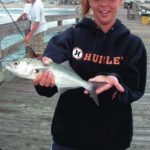


Be the first to comment